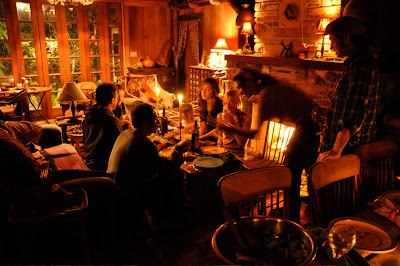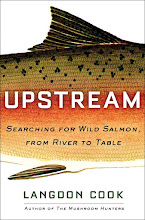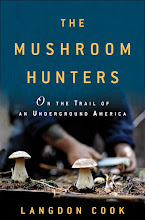It's no secret that I enjoy spending time with "the mushroom people." (Think 1950s sci-fi flick, with a menacing invasion of creatures who fail to conform to the American standard of ignorant mall-walker.) Many of the mushroom people I know, while being a diverse lot overall, share a few similar traits in common. They like to tromp around all day in the outdoors. By night they're in their kitchens, cooking up the day's catch and drinking wine. They take pride in lost skills such as recognizing the plants and animals around them; cooking from scratch; and home-brewing, distilling, and wine-making. What's not to like? These are my people.
And so it was a pleasure to recently visit the home in Gualala, California, of one of the mushroom people trailblazers ("take me to your leader..."). After the Albion weekend concluded a couple dozen of us drove an hour down the coast to David Arora's house, where another week of foraying and feasting went on, capped by a Saturday workshop on the magic of fire—hearth-cooking—taught by Arora's good friend William Rubel. Imagine lighting out for the universe only to find a planet where the people looked a lot like you but actually respected the natural environment and used its offerings to make wonderful food and drink.
Arora's house is the ultimate shrine to the mushroom people. The San Francisco Chronicle has already done a piece on it (click for slideshow), so I won't belabor the point. Just try to picture a labyrinthine cabin in the coastal mountains overlooking the Pacific, a place designed to entertain scores of mushroom people at once, with beds tucked away in corners and in lofts all over the house (including the amazing mushroom loft with its giant toadstool steps), five fireplaces for warmth, and several additional out-buildings for the overflow, including a "princess suite" and the "Saloon," where games of dominoes and cards are waged with drams of the hard stuff. I didn't see a single TV.
Arora is a collector. A collector of mushrooms, antiques, stories, even people. Guests included husband-and-wife jump blues musicians from Oakland, a public defender from Spokane, a Sonoma wine maker, a Washington State wine distributor, a wandering poet of unknown address, a local Mendocino forester, a Vancouver Island hotelier and co-founder of Slow Food Canada, another Canadian"nature awareness mentor," two seaglass divers from Santa Cruz, a San Francisco web developer, and the Ashland, Oregon-based discoverer of the world’s first aquatic mushroom.
The first night's revelry included a big sit-down dinner using Thanksgiving leftovers (Turkey and Chanterelle Tetrazzini), Hedgehog Crostini, a salad of baby lettuces and wild wood-sorrel, and an arsenal of wines complements of the guest distributor and hotelier. The toasting sticks (pictured left and below) got plenty of use and the musicians helped us work off dinner with a wild set of boogie-woogie.
Over the next few days a few of us made mushroom forays to Salt Point State Park, Jackson State Forest, and even on the property itself, which, during a midnight foray lit by headlamp, yielded baskets of white and golden chanterelles, matsutake, saffron milkcaps, shrimp russulas, and man on horseback mushrooms. Arora is a big fan of grilling marinated russulas over the fire, and I have to admit I'm now a believer in this edible mushroom that nevertheless often earns the distinction of being "better kicked than picked." After thoroughly cleaning the cap, just brush on some olive oil and chopped garlic before roasting over hot coals until both sides are lightly browned.
My last night was the hearth-cooking class. Along with a dozen students up from the Bay Area, we string-roasted legs of lamb by the fire, cooked wild greens and a mushroom tart over the coals, and made an amazing apple tatin—all by the hearth, with instruction (and occasional poetry readings) from Rubel. Great merriment and food enlivened a rainy night. It's hard not to see the hearth-cooking as a metaphor.
If this all seems like hagiography, let me say that in these dark days of the Republic, when our elected officials on both sides of the aisle will mostly be remembered as the butts of late night TV jokes, it seems high time to present an alternative vision. I couldn't imagine a better place to be on Black Friday than Mendocino County, among the mushroom people. The rest of the week only confirmed my belief in the need for Americans to cease trying to fill the voids in their lives with stuff and instead reconnect with immaterial things of true and lasting value.
I know, it's a tough choice: fight your way through the mall-walking throngs in search of the latest Furby—or sit around a table having a pointless discussion with other humans about such useless endeavors as art, travel, and natural history. After all, didn't we have a recent U.S. president who made a political virtue of his lack of curiosity?
If you think you'd like to present yourself as a candidate for mushroom people abduction, I'd recommend joining a local mycological club. My own, the Puget Sound Mycological Society, is one of the great deals in clubdom, with an annual membership of $30 that gets you invited to free forays all over the state during the spring and fall mushroom seasons as well as monthly meetings with speakers and slideshows and much more. Other storied places where the mushroom people meet include the annual Breitenbush Mushroom Conference in the Oregon Cascades, which includes all of the above fun plus natural hot springs, and SOMA Camp, a three-day event in January sponsored by the Sonoma Mycological Association.






















